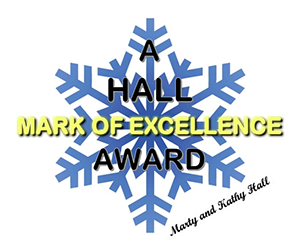 This World Cup coverage is made possible through the generous support of Marty and Kathy Hall and A Hall Mark of Excellence Award. To learn more about A Hall Mark of Excellence Award, or to learn how you can support FasterSkier’s coverage, please contact info@fasterskier.com.
This World Cup coverage is made possible through the generous support of Marty and Kathy Hall and A Hall Mark of Excellence Award. To learn more about A Hall Mark of Excellence Award, or to learn how you can support FasterSkier’s coverage, please contact info@fasterskier.com.
No other professional ski race can match the prestige and lore surrounding the Holmenkollen 50 kilometer race held in Oslo, Norway. Win it—and your name will be etched into history. Like all iconic sport competitions, once you are Holmenkollen champion, it’s a title which follows you forever. It’s also a title everyone desperately wants. Holmenkollen has earned its reputation; with over 6,000 feet (1,828 meters) of climbing, it’s generally viewed as the toughest 50 kilometer race in which professionals will compete. The focus this year would be all about Norway—and why not? Norwegian men have subdued the rest of the distance skiing world, having won each of the last 16 World Cup distance events and every distance event this season. Though with only 39 men starting, others were hoping for a chance to break through.
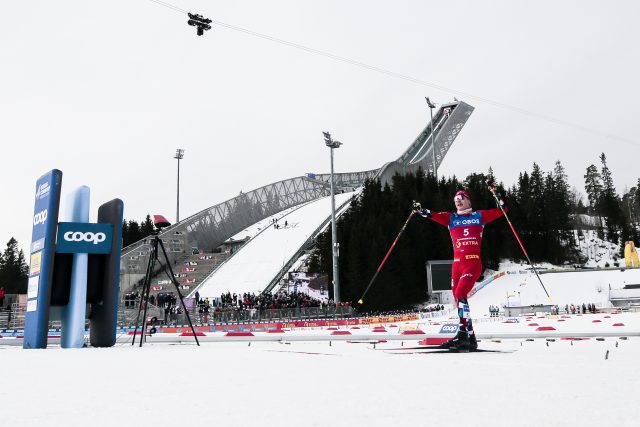
After dueling on the brutal Holmenkollen course, the Norwegian domination continued with Simen Hegstad Krueger (NOR) taking the win. He was followed by Hans Christer Holund (NOR) and Martin Loewstroem Nyenget (NOR). Norwegians took the top ten spots. Andrew Musgrave (GBR) was the top non-Norwegian finisher in 11th.
David Norris was rewarded for his globe-trotting taking the top American position, finishing 17th. “Today went well for me,” Norris said. “No major mishaps and I have pretty good energy considering my schedule. Third 50 in three weeks! I’m so grateful that the Steamboat Winter Sports Club allowed me to come here for two weeks. This has been a great experience.”
Among other North Americans, Scott Patterson was right behind Norris finishing 18th. Hunter Wonders was 23rd, followed by Gus Schumacher in 28th. The top Canadian was Olivier Leveille in 26th, while Russell Kennedy was 36th.
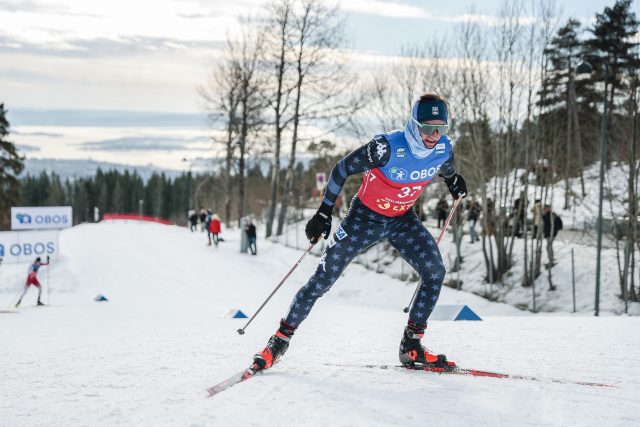
Holmenkollen 50 Kilometer Mass Start Freestyle
For Klaebo (NOR), a win today would go a long way to heal the wounds of last week’s second place finish at the World Cup 50 k. Klaebo would also be looking to eclipse countryman Martin Sundby for the most World Cup victories for a man in one season, currently both are tied with 14. Paal Golberg (NOR) would be in the difficult position of defending his World Cup Marathon victory from last week.
American fans would have their eyes on long distance standout David Norris who was attempting the unprecedented feat of winning the North American Birkebeiner, skiing in the World Championship Marathon the following week, and now, one week later, racing Holmenkollen.
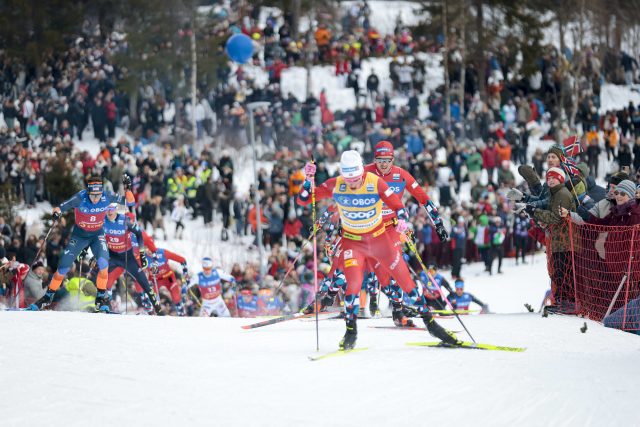
Klaebo took a different approach to today’s race as he went to the lead early and led through the first five kilometers. It was a marked contrast to the strategy he employed at last week’s World Cup 50 kilometer when he never went to the front. Early on, Klaebo seemed determined to not repeat last week’s events, quickly returning to the front whenever he was challenged. He was joined at the front by Golberg.
This pattern continued for the first 13.5 kilometers as the field stretched out at each bonus point sprint; then the inevitable contractions occurred, with Klaebo still out front. There were minor lead changes but each new leader was quickly replaced by Klaebo. The question was, would he maintain this strategy for the rest of the race?
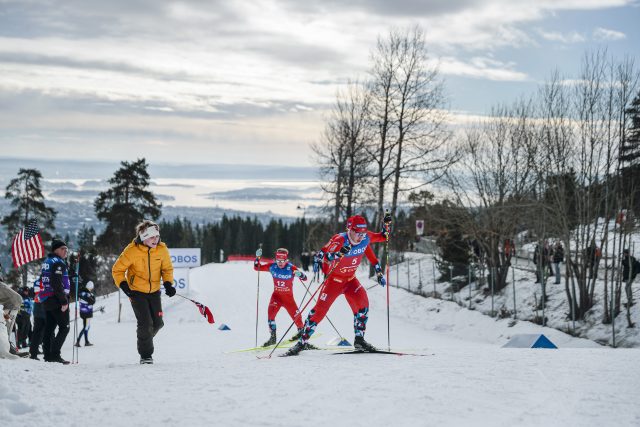
At 14 kilometers the answer was provided when Krueger (NOR) put in a turn of pace to lead the race. Klaebo now seemed content to sit behind Krueger. As skiers went through the stadium for the second time, all of the top contenders continued without exchanging skis. Krueger continued to lead with Klaebo pulling along side him for long stretches.
The Krueger-Klaebo duo continued to lead through the halfway mark of the race. Joining the front of the race was crowd favorite Andrew Musgrave (GBR) who generally shines at distance events; however, Musgrave’s time out front was short lived, and he wouldn’t be able to stay with leaders for long.
Even with Krueger and Klaebo out front, the field still had not fractured as there were still 30 athletes skiing in the lead pack.
At the start of third lap, the tone of the race would reset as the ski exchange strategy came into play. Kreuger and Holund (NOR) opted to exchange skis while Klaebo and Golberg remained on course. After the ski exchange, Kreuger and Holund dropped to 22 seconds behind the pack, but within one kilometer they had rejoined the back of the group.
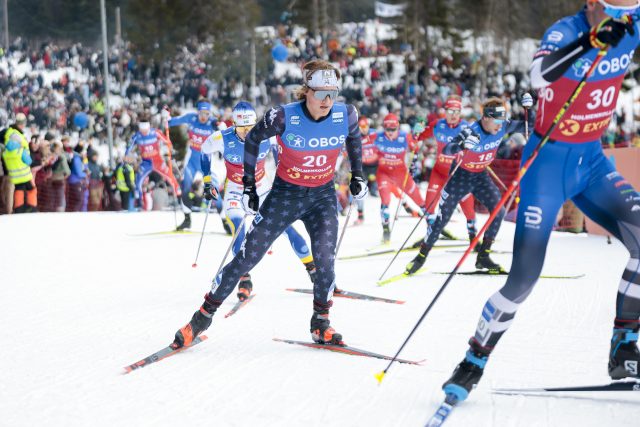
At 28 K, American fans received a thrill as Gus Schumacher surged to the front and went into third at the bonus point line. Also by this point, Holund had worked his way back to the front of the pack taking advantage of his fresh skis. Klaebo hung with him, and they began to seriously fracture the pack for the first time.
It was evident that Krueger and Holund had benefited from the ski exchange as they were out-gliding other competitors. Holund’s and Kreuger’s strategy had become clear: change skis early and press the pace, which is exactly what they did. In a moment, everything had changed as Holund and Krueger established a 10 second gap on the field where they were joined by lesser-known 22 year old Iver Tildheim Andersen (NOR) who had also changed skis early. The race was now getting serious with the lead three establishing a clear breakaway. Klaebo was suddenly 17 seconds off the lead.
The three leaders had gone all in with their strategy and there was no turning back now. They would be forced to defend their lead for another 17 kilometers. The strategy was put to a test at the fourth lap when the entire chase pack changed skis putting them further behind the break away pack, but giving them the opportunity to gain ground on faster skis. After the exchange, the pack was 42 seconds off the leaders.

The chasers seemed determined to close the gap. By 36 kilometers, the lead had narrowed to 32 seconds, with the chasers gaining time with each kilometer. With only 10 kilometers to go, the gap was down to only 28 seconds. It would be nip and tuck for the leaders to try and hold off the pack.
With the pace quickening even more, the chase pack began to break up. Martin Nyenget (NOR) and Harald Oestberg Amundsen (NOR) moved to the front of the chasers. Klaebo and Golberg had fallen back by about five seconds. It appeared that the top two World Cup 50 kilometer finishers were running out of gas.
At 42 kilometers, Klaebo was desperately trying to hang on to the chase group but was laboring mightily. Toenseth and Nyenget were quickly dropping the rest of the chasers who were now down to only two skiers. At the front of the race, the strategy of working together was now gone. Krueger decided that he needed to press the pace with Holund going with him. Andersen was dropped from the lead group.
The final three kilometers has some of the steepest climbing in the race which Toenseth and Nyenget would try and use to catch the leaders as they put in a burst to close the gap, but the leaders were not to be denied. Krueger put on a burst of his own with half a kilometer to go pulling away from Holund to ski into the stadium with a five second lead. Holund was able to hang on for second with Nyenget finishing third. The young Andersen was able to hold on to fourth place for a dramatic Holmenkollen finish for him.
Once the exciting Holmenkollen drama was settled, it was all Norway in the top ten, but Klaebo would still be left searching for the landmark marathon victory which has eluded him throughout his career.

Holmenkollen 50 Kilometer Mass Start Freestyle RESULTS
Holmenkollen 50 Kilometer Mass Start Freestyle RESULTS



